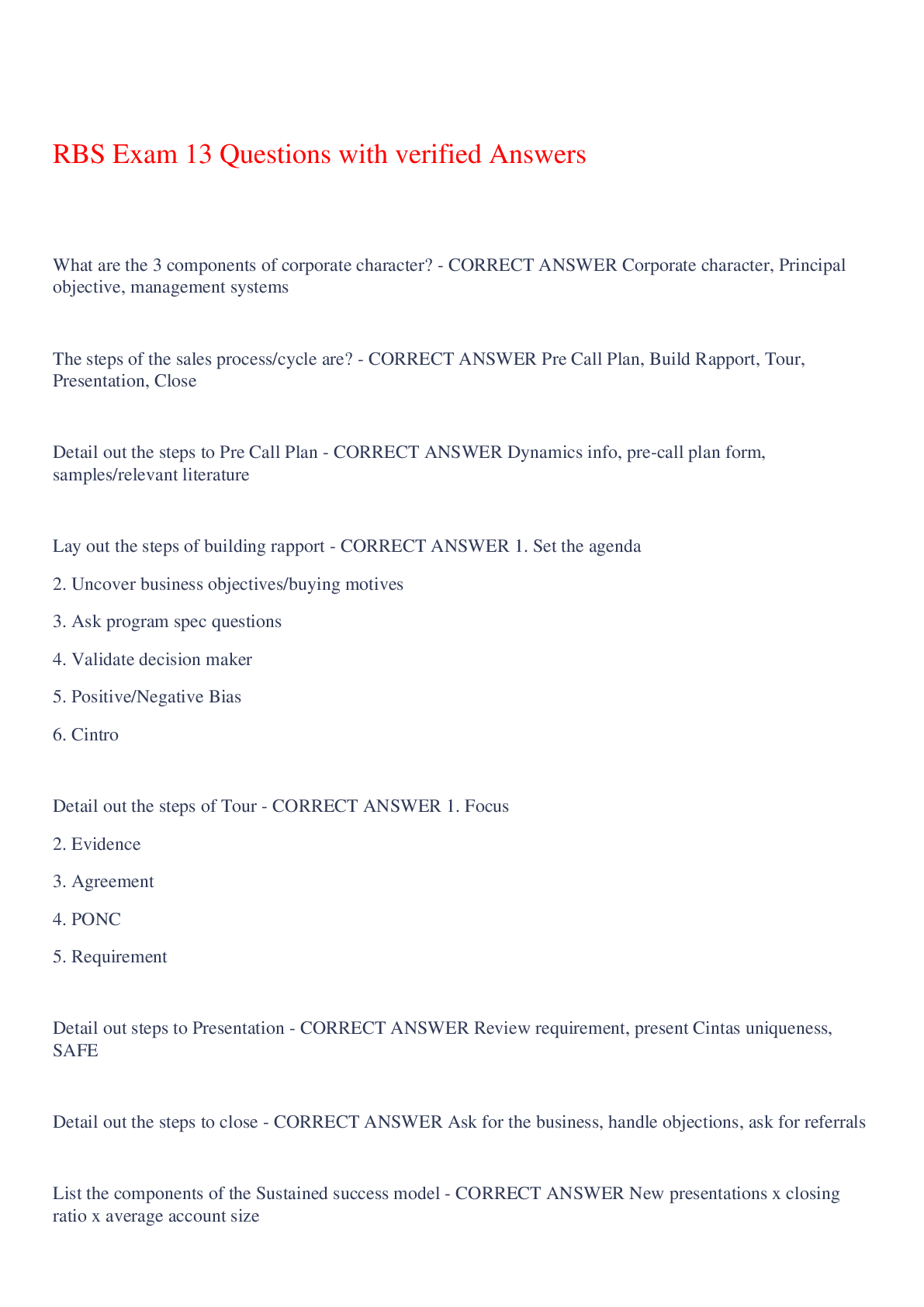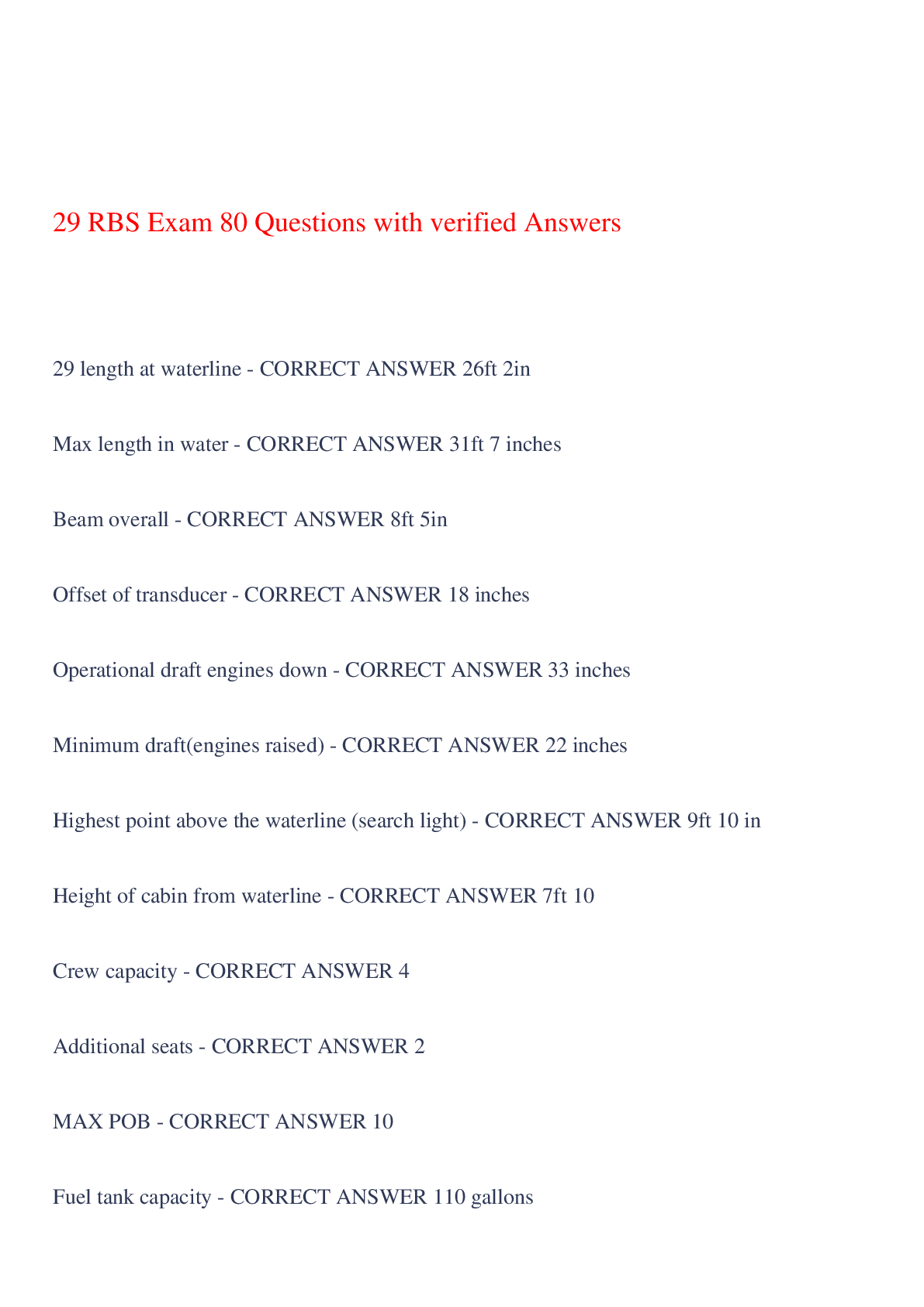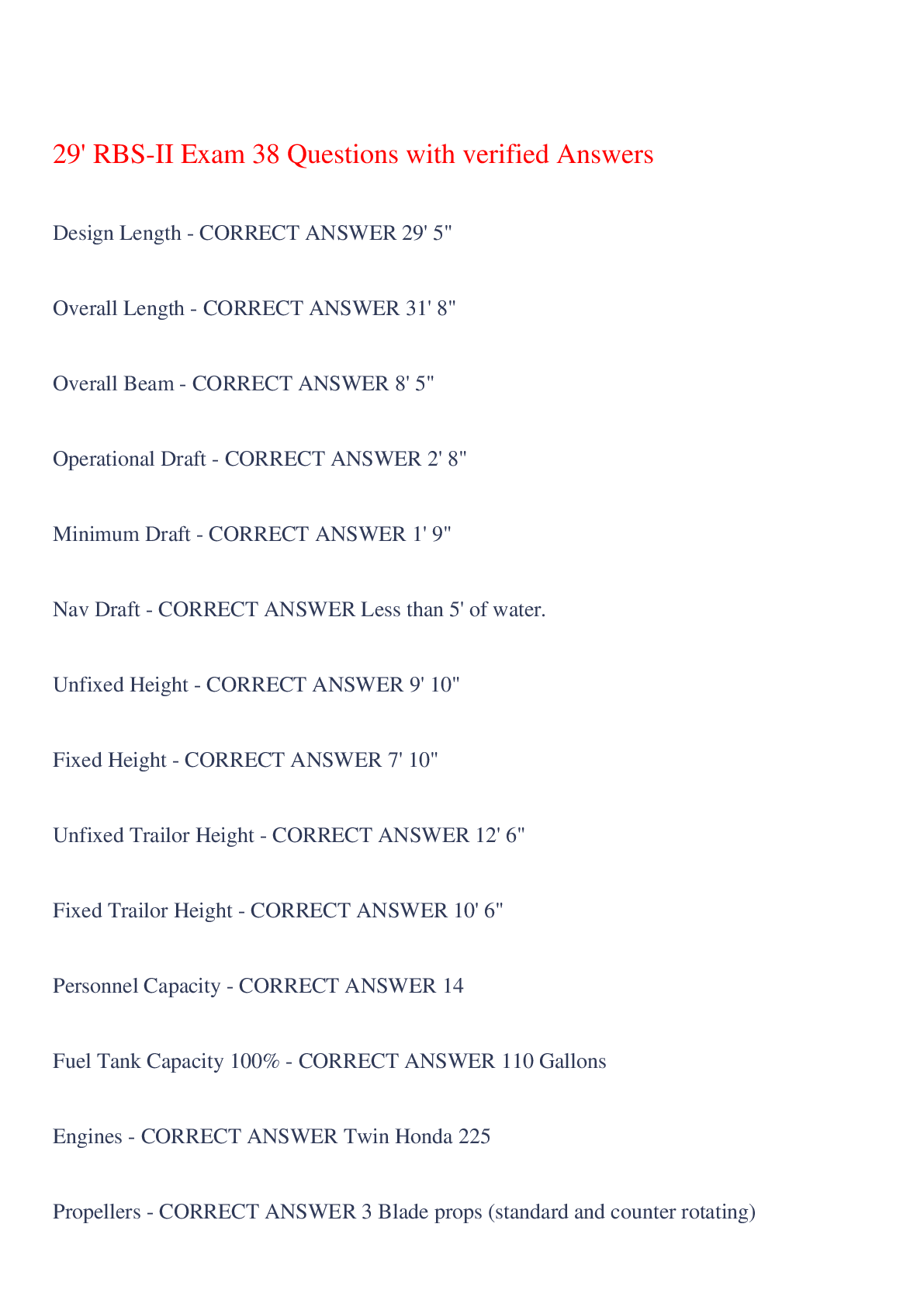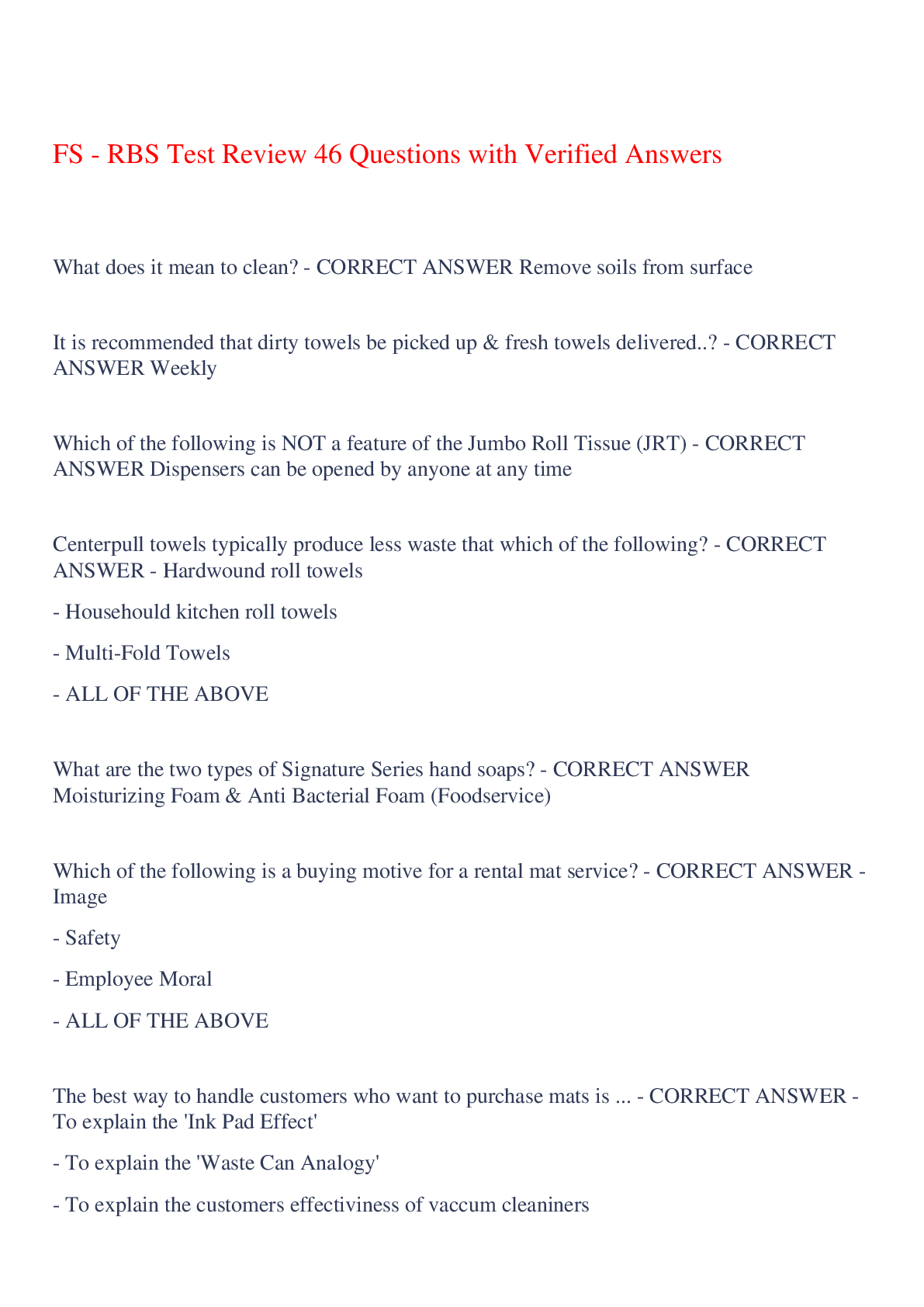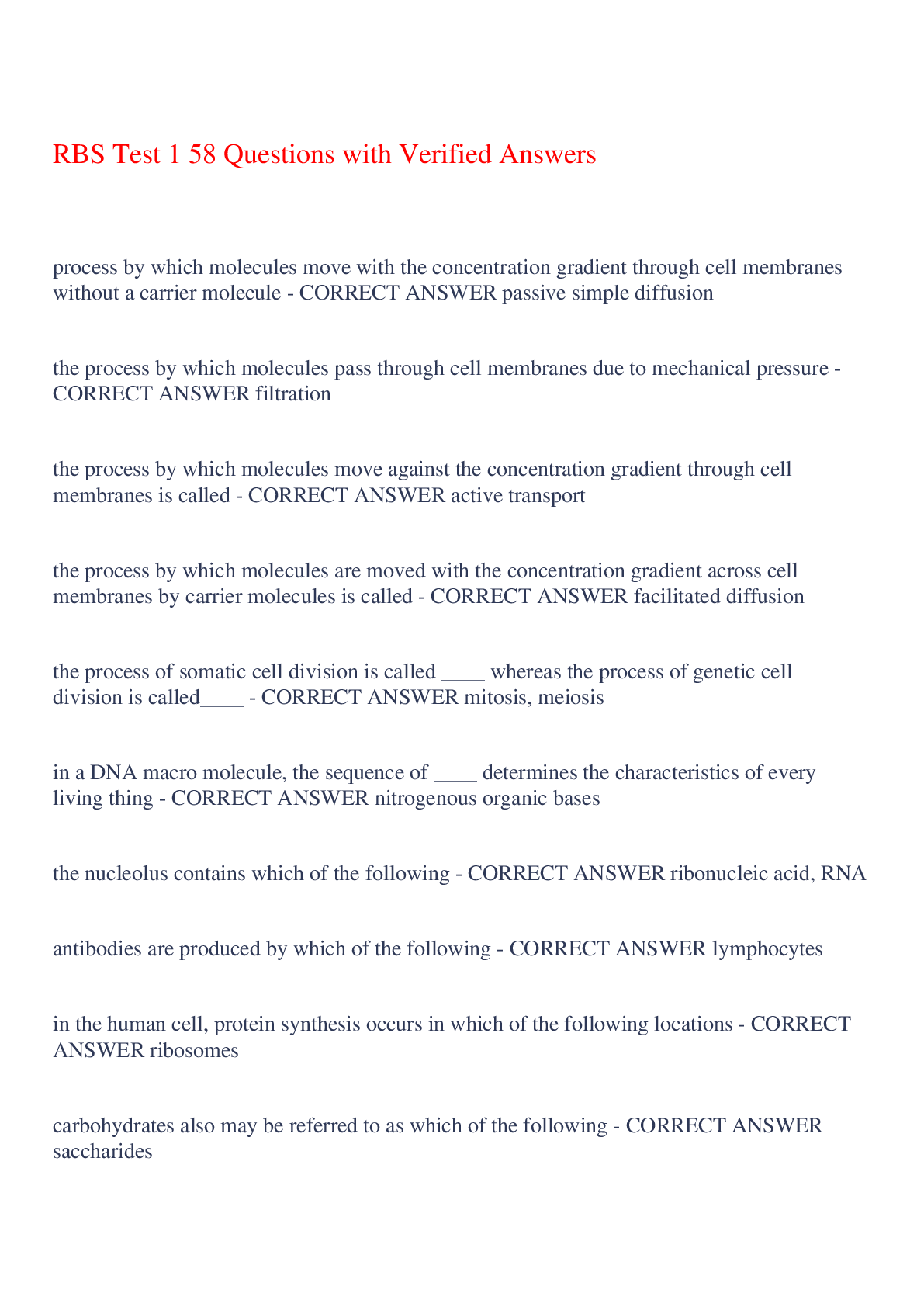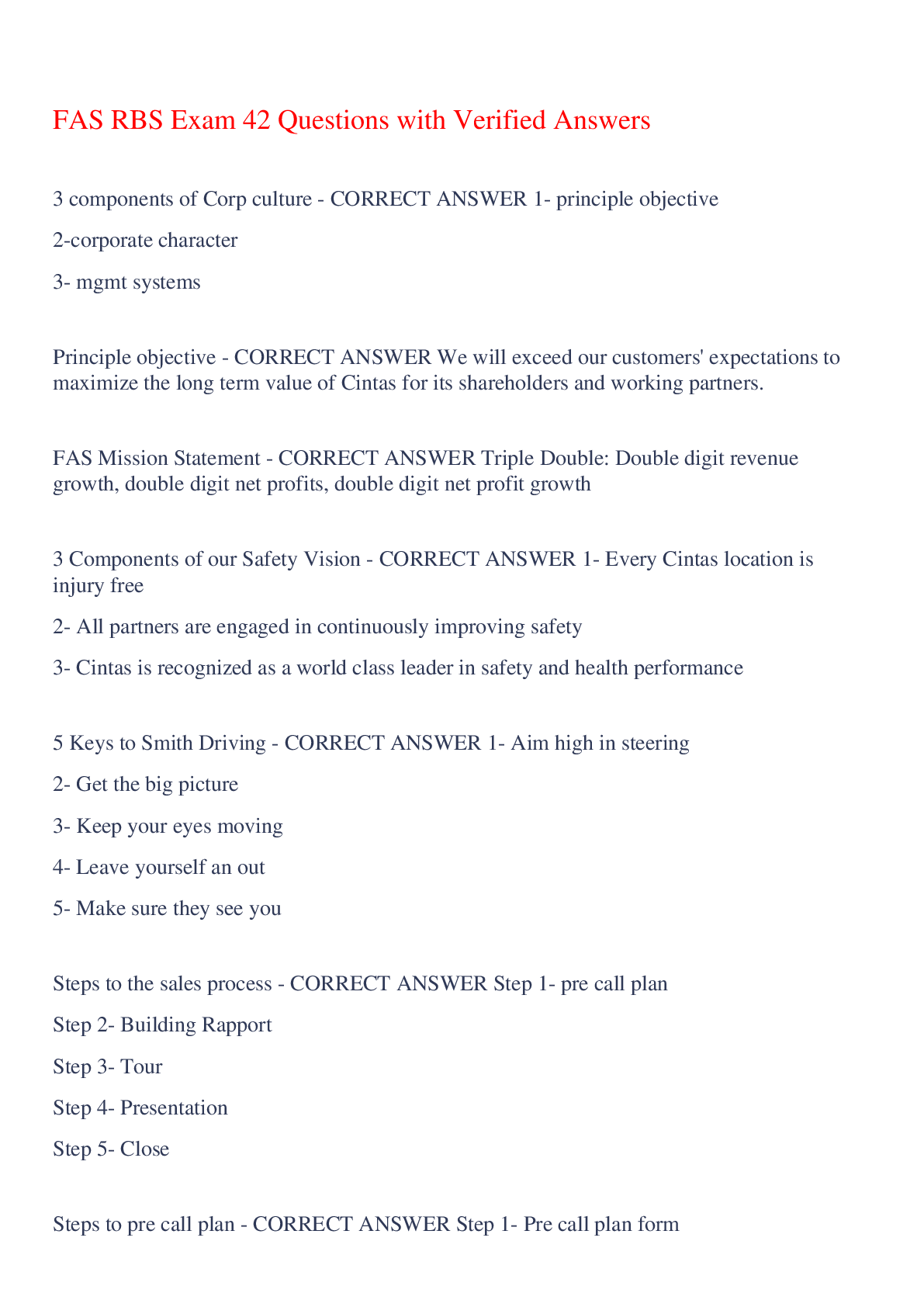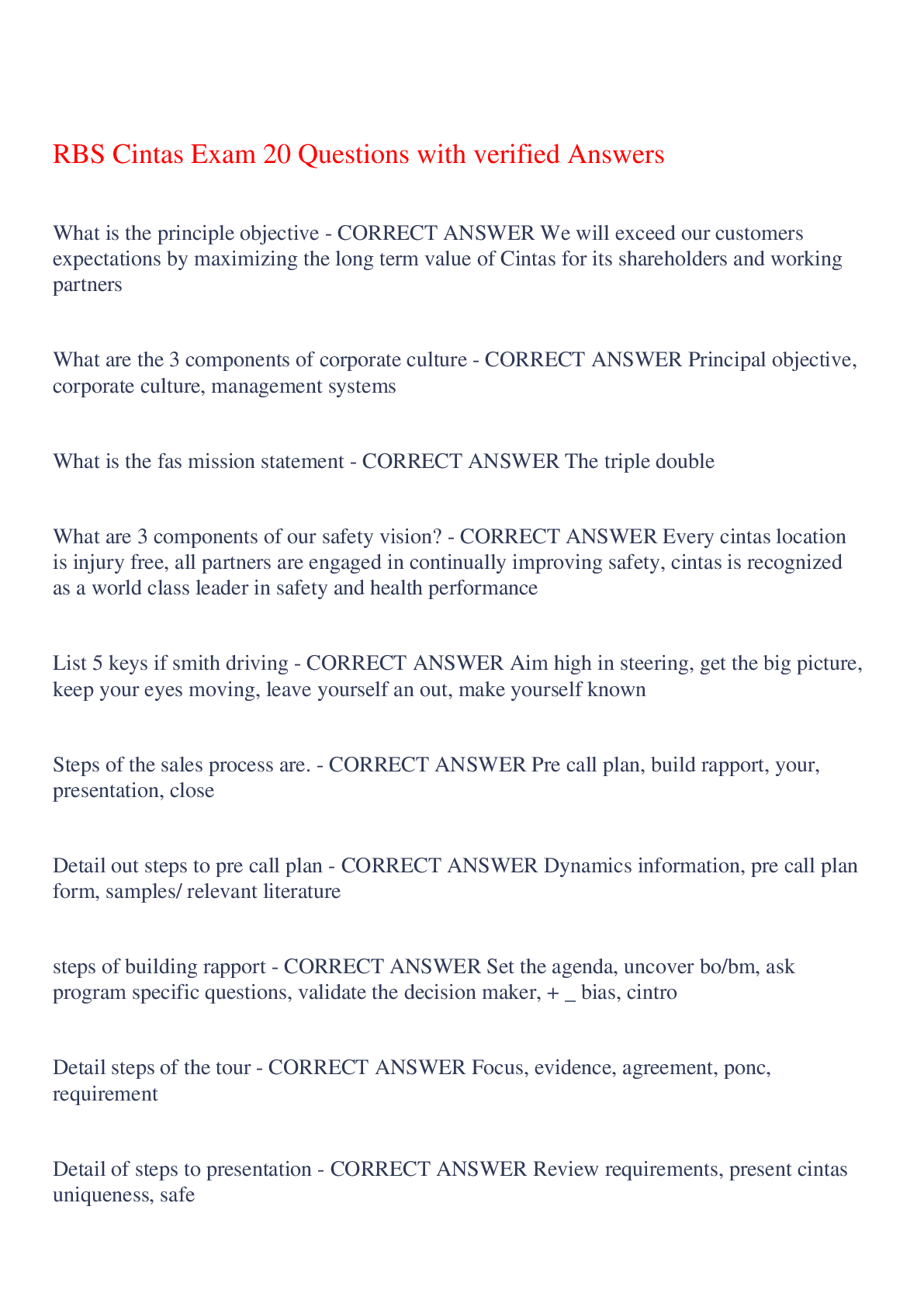CFRN: Flight Physiology 40 Questions with Verified Answers,100% CORRECT
Document Content and Description Below
CFRN: Flight Physiology 40 Questions with Verified Answers What is Boyle's Law? - CORRECT ANSWER Boyle's Balloon Balloon expands as rises 2/2 less pressure against it. *Think of things ABOVE ... sea-level* Closer to sea-level, more barometric pressure. Gas volumes expands as barometric pressure ↓ Temperature is the same What are the common medical problems associated with Boyle's law? - CORRECT ANSWER ~Arterial gas embolism (needs to be in a pressurized aircraft) *~pneumocephalus 2/2 depressed skull Fx* ~Barotitis Media (middle ear) ~Barodontalagia (air under tooth) ~Barosinusitis (sinus) ~Barobariatrauma (like the bends) Barotitis Media - type of problem & Tx - CORRECT ANSWER A *descent* problem Tx: Easiest way to fix, go back to altitude Valsava maneuver Neosyneprhine or Afrin to vasoconstrict Treat pain symptomatically Barodontalagia- type of problem & Tx - CORRECT ANSWER An *ascent problem* Seen with newer dental work Tx: analgesics, slower descent, Boyle's Law Barosinusitis- type of problem & Tx - CORRECT ANSWER An *ascent (more so) but can be decent* problem Seen with sinusitis Tx: analgesics, Afrin and slower ascent. Barobariatrauma- type of problem & Tx - CORRECT ANSWER An *ascent problem* Seen with morbidly obese patients (more lipid tissue=more nitrogen) Gases in adipose tissue released into plasma causing nitrogen narcosis "bends" Tx: 100% O₂ to wash nitrogen from lungs (pre-oxygenated for at least 15 minutes prior to ascent and high concentration for duration of transport) What are some aeromedical considerations of Boyle's law? - CORRECT ANSWER *air in tubes* ~ETT (create minimal air leak - can replace with water, but would need to change out ETT once landed) ~IV drips - may see rate accelerate with ascent and converse ~MAST pants - ↑ in altitude, air ↑ - OK if have pop-off valves (as descend, ↓ in air pressure) ~Casts <7 days old bivalved, ace wrapped and neuro checked frequently ~IABP ~Chest tubes: vent chamber to atmosphere or air will be forced back into patient. (can place heimlick valve in between pt and pleurovac to prevent air backing up to) ~Foleys can push air or dirty urine back into patient but does not affect foley cath balloon What is Charles's Law? - CORRECT ANSWER A Law of VOLUME proportional to temperature (e.g. football inflated inside, shrinks when outside in the cold) ~for every 100 m climb = 1°C ↓ drop ~heated gas expands volume (e.g. can of shaving cream into a fire) *THINK TEMPERATURE* Law has little effect on human body (we are at a relatively constant temperature) What is Gay-Lussac's Law? - CORRECT ANSWER "Charles Gay brother" *SAME law except, except Gay is about PRESSURE* Volume is the same, lower temp - lower pressure, higher temp - higher pressure e.g. *heat applied to an O₂ tank, O₂ cylinder is fixed vessel; so with temp change throughout day will change pressure* e.g. put nitrogen in tires in CO - b/c it does not change w/ temp - so you don't have to add air in winter, take it out in the summer What is Henry's Law? - CORRECT ANSWER Henry's Heineken (solubility of gas in a liquid) *Think BELOW sea-level - the bends, nitrogen* MOST IMPORTANT GAS LAW TO UNDERSTAND - *the way we treat hypoxia* How to manipulate Henry's Law: (1) ↑ concentration of gas (↑ % O₂) (2) Pressurize the gas (BiPAP/CPAP/ET-vent) (3) Change surface area (add PEEP - prevents alveoli from collapsing when they exhale) Partial pressure in capped Heineken beer bottle is equalized with air in neck of bottle until you pop the top and a gas gradient exists What is Graham's Law? - CORRECT ANSWER Graham's grape jelly (opposite of Henry's Law) *gas bubbles coming out of grey matter at altitude* Law that governs what the resistance is, when you are trying to put the gas in the first place. *Dictates gas exchange at cellular level - always about equality* 1) How big is the gas molecule? (helium vs O₂) 2) What is the density of the fluid? (more dense, harder to move aside for gas) ~Gases with lower mass diffuse faster than those with high density ~Dictates gas exchange at molecular level ~Always goes from higher to lower gradient ~CO₂ travels through water 20-40x faster than O₂ Pt with PNE - takes more time for O2 to diffuse across membrane 2/2 all the shit in the way What is Dalton's Law? - CORRECT ANSWER Dalton's Gang (multiple gasses, like a gang that needs multiple people) *tissue swelling at altitude* TOTAL pressure of gas mixture is the SUM of the partial pressures of ALL THE GASES in the mixture The percentage of oxygen does NOT change with altitude, what changes is how crammed the molecules are together Sum of all partial pressures added together will give total pressure of the environment What are 8 stressors of flight? - CORRECT ANSWER All of these are *INHERENT stressors* 1. G forces 2. Decreased humidity 3. Thermal changes 4. Noise 5. Vibration 6. Decreased partial pressure of oxygen (Dalton's Law) 7. Fatigue 8. Barometric pressure What does DEATH stand for in relation to factors effecting stressors of flight? - CORRECT ANSWER All of these are *SELF-imposed* ~*D*rugs (benadryl, BB, +big ones like fentanyl) ~*E*xhaustion (dehydration adds to this as well) ~*A*lcohol ~*T*obacco (reduce NV by 4000') ~*H*ypoglycemia What does *MSL* stand for? - CORRECT ANSWER *Mean Sea-Level* 4300 MSL is 4300 ft ↑ sea-level. Takes into account tides - most common term ASL - above sea-level - does not account for tides What does *AGL* stand for? - CORRECT ANSWER *Above Ground Level* You can be 1000 AGL but 7400 ↑ sea -evel. Distance below the plane to the ground What does *ATM* stand for? - CORRECT ANSWER *Atmosphere* 1 ATM weighs: 14.7 lbs or *760 mmHg* (torr) - measurement used in aviation Closer to sea-level - more pressure there is (Denver 7000' to 8000' not nearly as significant as Florida sea-level to 1000') What does torr stand for? - CORRECT ANSWER Measurement of pressure in mmHG What does psi stand for? - CORRECT ANSWER Pressure per square inch. A measurement of pressure, in psi What is atmospheric pressure? - CORRECT ANSWER The weight of 1 square inch column of air extending from sea-level into space - it actually has a weight *@ sea-level* = *1 ATM* *33 ft*↓ sea-level = *2 ATM* *66 ft* ↓ sea-level = *3 ATM* (1) ATM weighs how much torrr? - CORRECT ANSWER 760 torr As you ascend what happens to pressure? - CORRECT ANSWER It ↓ (lessens) What are the 4 zones of altitude? - CORRECT ANSWER 1. *Physiologic zone* (sea-level to 10,000 ft) 2. *Physiologic deficient zone* (10,000-50,000 ft) when even a healthy person starts to see physiologic changes (body is compensating - not used to it) 3. *Space equivalent zone* (50,000-250,000 ft) (65,000 ft - Armstrong's Line - point where barometric pressure in atmosphere is↓ than the barometric pressure in the body - you can't on-gas and all gas you have in the body, escapes - leaves your body!) 4. *Space* (250,000 ft.) CAMES guidelines recommend supplemental O2 for prolonged duration at greater than 9000 ft As you dive what happens to pressure? - CORRECT ANSWER It ↑ *Every 33 ft ↓ + one ATM* If you dive ↓ 66 ft = 2 water ATM & 1 air ATM ∴ total 3 ATMs *Related to Henry's Laws* What is *hypoxic hypoxia*? - CORRECT ANSWER *Suffocation* Can't get O₂ into body Only hypoxia you can r/o with an SpO₂ What is *stagnant hypoxia*? - CORRECT ANSWER *Blood is stagnant, so O₂ isn't going anywhere* Think of train station, lots of Pts (O₂), lots of cars (Hgb) - train isn't moving i.e. CHF, PE, shock @global level= compartment syndrome - @ local level=tourniquet) What is *histotoxic hypoxia*? - CORRECT ANSWER Failure of body tissue to use available oxygen *histotoxic = toxic* i.e. cyanide poisoning, metabolic disorder, CO, sodium nitroprusside (it goes into the liver and when metabolized - it turns into cyanide) What is *hypemic hypoxia*? - CORRECT ANSWER Decrease in oxygen carrying capacity in the blood. *Think hypemic = anemic* One of the most powerful forms of hypoxia in the body - cut Hgb in ½, cut O₂ in ½ i.e. anemia, hemorrhage, CO poisoning, sickle cell What are the 4 stages of hypoxia? - CORRECT ANSWER 1. Indifferent stage 2. Compensatory stage 3. Disturbance stage 4. Critical stage What S&S do you have with *indifferent stage of hypoxia*? - CORRECT ANSWER Person can still compensate Only stage where you will still be able to think critically ↑ HR and RR ↓ night vision Whats S&S do you have with *compensatory stage of hypoxia*? - CORRECT ANSWER ↑ BP Impairment of task performance occurs - loose critical thinking - get stoned ~You won't recognize that you are hypoxic What are the S&S of *disturbance stage hypoxia*? - CORRECT ANSWER Dizziness Sleepy Tunnel vision Cyanosis What are the S&S of the *critical stage of hypoxia*? - CORRECT ANSWER Marked mental confusion Incapacitatation Death unless fixed PaO₂ ↓ by how much for every 1000 ft of altitude? - CORRECT ANSWER *↓5mmHg* What is the formula for *FiO₂ adjustment* calculation? - CORRECT ANSWER This formula allows you to keep the same O₂ concentration at a different altitude. P1 = barometric pressure the Pt is currently at P2 = barometric pressure the Pt will be GOING % FiO₂ x P1 ----------- = FiO₂ for new altitude P2 (30 % x 760 torr) -------------- = 37% 620 torr What is effective performance time? - CORRECT ANSWER EPT = amount of time a person is able to perform useful flying duties in an inadequately oxygenated environment What is time of useful consciousnesses? - CORRECT ANSWER TUC = the *time from exposure to O₂ deprivation to point deliberate function is lost* How LONG can you protect yourself in an inadequately oxygenated environment? Most important for us in air/medical Higher we go, the more it goes down How is time of useful consciousness affected, in the setting of an explosive decompression? - CORRECT ANSWER *It is cut in half* They hear a pop from rush of air and see fog in cabin from condensation (2/2 temperature change from outside of cabin to inside of cabin) What is the difference between Type 1 and Type 2 Decompression Sickness? - CORRECT ANSWER *Type 1* - nitrogen related, painful joints, mottled skin, pruritic (itching) *Type 2* - neurological S&S, hypoglycemic shock *Difference is neurological* What type of G-forces are best tolerated by people? - CORRECT ANSWER Gx - *anterior/posterior* force, best tolerated, e.g. accelerated in your car (+Gx when a dragster takes off and - Gx when they deploy a parachute) Gz - vertical force, e.g. falling from roof, landing on feet Gy - lateral force, LEAST tolerated, e.g. T-bone MVA [Show More]
Last updated: 7 months ago
Preview 1 out of 11 pages

Buy this document to get the full access instantly
Instant Download Access after purchase
Add to cartInstant download
We Accept:

Reviews( 0 )
$8.50
Document information
Connected school, study & course
About the document
Uploaded On
Nov 03, 2023
Number of pages
11
Written in
Additional information
This document has been written for:
Uploaded
Nov 03, 2023
Downloads
0
Views
44















